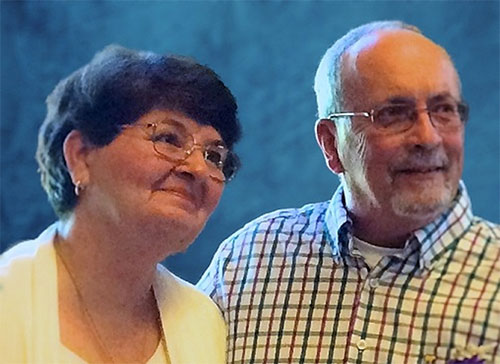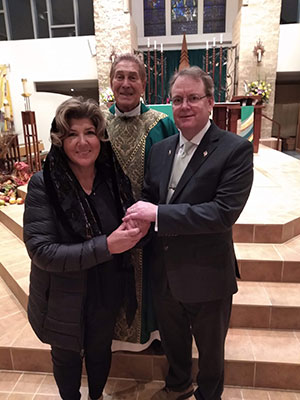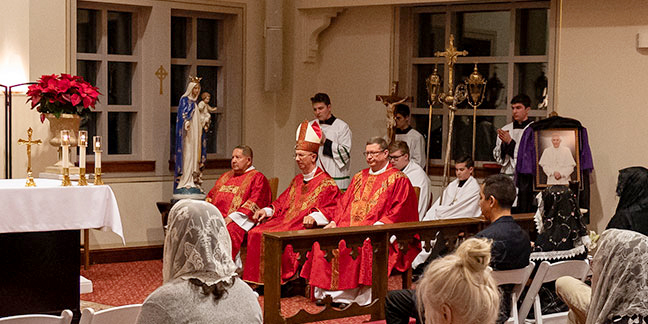Married couples in western North Carolina have the chance to rediscover each other on three weekend retreats in 2023
 Bill and Lyn FolsomCHARLOTTE — Tampa Bay couple Bill and Lyn Folsom were headed for divorce until Lyn presented a possible solution for reconciliation.
Bill and Lyn FolsomCHARLOTTE — Tampa Bay couple Bill and Lyn Folsom were headed for divorce until Lyn presented a possible solution for reconciliation.
“It was a ‘double-dog dare’ from my wife to me to make a Retrouvaille weekend if I was serious about saving our marriage, which was in pretty bad shape at that time,” Bill recalled.
Bill took the dare. He had nothing to lose. At the time, the couple had two children, and Lyn had already filed for divorce.
That was 35 years ago. Now married for 55 years, the Folsoms are enjoying their lives together.
“We were prepared to march 180 degrees in different directions, divorce and just go on with our lives, but we got back together,” he said.
“It was a struggle, but we did it, and our two youngest children wouldn’t have been born if we hadn’t. If we hadn’t gotten back together, half our grandchildren wouldn’t be here. Our two youngest kids are very thankful for Retrouvaille!”
RETROUVAILLE IN WESTERN NORTH CAROLINA
Couples in troubled marriages in western North Carolina have the same opportunity for healing Jan. 13-15 at the Catholic Conference Center in Hickory.
They will listen to engaging talks from other married couples, including the Folsoms, who have navigated the path of reconnecting a disconnected marriage.
The presenting couples openly share how they have experienced healing and forgiveness in their own marriages. Then, attending couples follow guided exercises to practically apply the lessons learned.
The Folsoms have helped thousands of couples reconcile ever since their Retrouvaille weekend in 1987.
“We were interested in giving back, so we went on a Formation Weekend, and they asked us to write some presentations for the post sessions, which is the six-week follow-up part of the program,” Lyn Folsom said. “Eventually, in those early days, we wrote all 12 talks, which are about an hour to two hours long.”
A few years ago, the couple moved to Waxhaw, N.C., at a time when it was difficult to make new friends due to the pandemic, but they did meet George and Dolores King, who were involved in Retrouvaille, too.
At the time, couples in western North Carolina had to make a trip to the Raleigh area to attend one of the weekends. Now, as of July 1, 2022, Bishop Peter Jugis has granted permission to form and run a community in the Diocese of Charlotte. The community’s first weekend was held in October 2022. Three weekends are scheduled for 2023. After the January weekend, two others will be held April 14-16 and October 20-22.
INSPIRED BY HOLY SPIRIT, LED BY ST. JOSEPH
 George and Dolores King French for “rediscovery,” Retrouvaille originated in Quebec, Canada, in 1977 and soon spread to the United States and throughout the world.
George and Dolores King French for “rediscovery,” Retrouvaille originated in Quebec, Canada, in 1977 and soon spread to the United States and throughout the world.
The nonprofit, all-volunteer ministry has a powerful patron in St. Joseph, whose intercession has helped the success of the ministry. Though Catholic in origin, people of all faiths or no faith at all are welcome.
Dolores King says that the focus of the program is to facilitate conversation between the spouses and that allows for healing.
There’s no pressure spiritually as the goal isn’t conversion to the faith – it’s to help marriages. However, conversions do happen, the Folsoms and Kings attest.
Couples don’t share their struggles with the group. The program is all about learning to apply the communication tools together, King said. After the weekend, there are six follow-up sessions to help couples apply the new tools they learned through a deeper look at various aspects of married life.
The Kings, who have seven daughters, made their own Retrouvaille weekend in 2004.
“I knew of maybe one happily married couple. I thought marriages were difficult, and that was just par for the course, but I didn’t know how to work through the struggles,” Dolores King recalled. “It wasn’t until making our weekend that we made a breakthrough. Being involved in the ministry helped us apply the tools that we learned on the weekend, so it kept us accountable.”
The relatability of the presenting couples is an effective way of reaching couples who may not feel they can be helped.
“No one ever really arrives, because we are constantly growing, learning and loving. As we apply the skills and tools we learn, we grow closer and discover peace, joy and what we did not have before ... hope. We also learn that love is a decision, as is forgiveness, trust and communication.
“Acceptance too is a big part of loving and working together,” King said. “It’s not something that just happens. Love is a decision, not what you read in the fairy tales or romance novels. Love is staying up with your child who has a fever and you’re so exhausted, but you’re at that baby’s side, or your husband loses his job, and you believe in your husband.”
— Annie Ferguson
To register
To register for a Retrouvaille weekend, visit www.helpourmarriage.org or call 704-702-2112 for additional information. The $350 fee covers food, lodging and materials.
Financial assistance is available.

CHARLOTTE — Upon hearing the news of Pope Emeritus Benedict XVI's death on Jan. 1, Monsignor Patrick Winslow, vicar general and chancellor of the diocese, reflected on his legacy and the unforgettable experience of being in Rome to witness the new pope's election in 2005.
“This is a bittersweet moment for us. Pope Benedict has given his life in service of the Church and of God, and humbly stepped aside as he became frail, to allow others to lead – it really is a graceful departure from this phase of his journey toward God,” Monsignor Winslow said during interviews with local media. “The Catholic Church is really a family, and we feel this as if it is the death of a grandfather.”
“He had a huge impact on the Church,” he added. “He was an academic, and that sharp intellect – that mind, with his crystal clarity – really did a lot to shape our thinking, our doctrine and what we believe.”
Monsignor Winslow shares the following story of witnessing the election of Pope Benedict XVI in 2005, when he and another priest were in Rome leading a pilgrimage. Pope John Paul II had died on April 2, and the cardinals of the Church had gathered in Rome to elect his successor, in what is called a “conclave.” The conclave opened April 18 – the day before Monsignor Winslow and his group of pilgrims arrived in Rome…
On April 19, 2005, I landed in Rome with Father Timothy Reid, my parents, and two busloads of pilgrims who were mostly from the Diocese of Charlotte. Arrangements for our pilgrimage to Rome had been made a year earlier, so we could never have imagined our arrival would come in the wake of Pope John Paul II’s funeral and the first full day of the conclave to elect his successor.
Even though one never gets a reasonable night's sleep on a transatlantic flight, our tour began the moment we retrieved our luggage. Thankfully, exhaustion gave way to excitement and the effects of Italian coffee. We went right away to visit one of Rome’s major basilicas and enjoy some Italian food, before heading to our hotel to check in. The hotel was located only a mile or two from the Vatican – an ideal location for the history-making event we were about to witness.
Father Reid and I knew the group of cardinals meeting for their conclave in the Sistine Chapel could elect a new pope at any time, so we wanted to be ready. We told our tour guides that no matter where we were when white smoke began rising from the Chapel – the public sign that a pope has been elected – we wanted to drop everything, load our pilgrims on buses, and head over to St. Peter’s Square in hopes of getting a glimpse of our new pope.
Moments later, some children from our group in the hotel lobby pointed to the television and announced, “There’s white smoke!” We had to look carefully at the images flashing across the TV, as it sometimes can be difficult to tell whether the smoke is black (no pope elected yet) or white (a new pope has been elected). Father Reid and I thought the smoke looked white, so we ran to collect the members of our group. Our guides marshalled everyone onto buses while Father Reid, my parents and I hailed a taxi for St. Peter’s Square to find a prime viewing spot for our group. Hopping in the cab, we exclaimed in broken Italian, “We need to get to St. Peter’s Square immediately. We have a pope!” Our driver turned the radio dial from a soccer game to the news, then floored it.
What we saw next was extraordinary – almost terrifying. People poured out of Rome’s narrow streets, filling the expansive square in front of St. Peter’s Basilica like dozens of tributaries flooding a mountain reservoir. Our group made its way through the sea of people to the fountain along the southern arm of Bernini’s colonnade that extends from the basilica and surrounds St. Peter’s Square. From that vantage point, we could see the Loggia, the balcony from which the papal coat of arms of Pope John Paul II hung and where our new pope would soon emerge.
The official arrival of the cardinal deacon onto the balcony was met with uproarious energy from the rapidly assembled crowd, which at this point filled the main street of the Via della Conciliazione toward the River Tiber. Rome’s cacophony of church bells, which began ringing as the white smoke appeared and continued tolling for 45 minutes, went silent. From the balcony, the cardinal deacon declared: “Habemus papam.” (“We have a pope.”) Then we heard him say the name Cardinal Joseph Ratzinger, the new pope who would now be called “Pope Benedict XVI.” The crowd erupted in cheers.
That first glimpse of Pope Benedict was almost overwhelming, seeing him in white and red, walk out on that balcony, waving with both hands, and knowing he would now lead our worldwide Church, whatever might come. He offered his first blessing “Urbi et Orbi” – for the city and the world.
Pilgrim and parishioner Debbie Kovacich of Sparta recalled in a note to me on Saturday: “It was a singularly wonderful moment for us standing shoulder to shoulder with hundreds of people when the Holy Father stepped out onto the balcony…Later, when discussing other candidates for the papacy, I said something like, ‘Some people just wanted a rock star.’ You said, ‘They got one.’”
Ratzinger was perhaps the most well-known of all the cardinals in the Church at the time. He served closely alongside Pope John Paul II as the prefect for the Congregation for the Doctrine of the Faith, a position which he used to explain the faith clearly and eloquently – most notably in compiling the Catechism of the Catholic Church we use today. He was also a prolific writer and theologian who participated in the pivotal work of the Second Vatican Council, and through his leadership he formed many aspects of the Church and Her People, even if some passive observers throughout the world were unaware.
At that moment as a priest, a student of theology and as a pilgrim soul, I was grateful for the shepherd who had been given to us. Steadfast, gentle and thoughtful, our new Holy Father, Pope Benedict XVI, would go on to demonstrate his love for God in everything he said and did.
Charlotte bishop praises late pope at Jan. 5 memorial Mass
 CHARLOTTE — A requiem Mass, or Mass for the Dead, was offered Jan. 5 for the late Pope Emeritus Benedict XVI by Bishop Peter Jugis in Charlotte.
CHARLOTTE — A requiem Mass, or Mass for the Dead, was offered Jan. 5 for the late Pope Emeritus Benedict XVI by Bishop Peter Jugis in Charlotte.
The Mass at St. Patrick Cathedral’s temporary chapel drew about 60 people. It was one of many memorial Masses offered at churches around the Diocese of Charlotte on the same day that the former pope’s funeral and burial were held in Rome.
In his homily, Bishop Jugis recalled the late former pope as a courageous and faithful disciple of Jesus and an example for others to follow.
The bishop praised Pope Benedict’s scholarship and many writings – not just his pivotal work on the Catechism of the Catholic Church and papal encyclicals such as his 2005 “Deus Caritas Est” (“God is Love”) – but also his three-part series “Jesus of Nazareth,” published by Doubleday in 2007.
The three books recount the life of Jesus in a easy-to-read style designed for believers and non-believers alike: “The Infancy Narratives,” “From the Baptism in the Jordan to the Transfiguration,” and “Holy Week: From the Entrance Into Jerusalem To The Resurrection.”
Throughout his ministry, and especially in his writings, Pope Benedict sought to help people find a deeper, more personal relationship with Jesus, Bishop Jugis noted.
“Just as the apostles proclaimed Christ and His Gospel, so also the successors of the apostles are called to proclaim Christ and invite people to meet Jesus their savior and to enter into a personal relationship with Him,” Bishop Jugis said. “This is exactly what Pope Benedict does in his book ‘Jesus of Nazareth.’ He presents the Person of Jesus to us as Jesus is really presented in the Gospels – not according to someone’s opinion that we find in many modern-day writers, or according to some predetermined agenda, but as Jesus is presented to us by the Gospels.”
Bishop Jugis highlighted a quote from the introduction of the late pope’s encyclical “Deus Caritas Est”: “Being Christian is not the result of an ethical choice or a lofty idea, but the encounter with an event, a person, which gives life a new horizon and a decisive direction.”
“He got to the heart of Christianity there,” the bishop said. “It is knowing and following Jesus, after all, that makes us Christians.”
Yet the late former pope also realized that the message of Jesus is meant for all people to hear, the bishop continued. “Jesus is the answer to the world’s search for meaning and search for God. Jesus is the Way and the Truth and the Life.”
The late former pope knew that the increasingly secularized culture of the modern world needs to find its way back to God, Bishop Jugis said.
“All you have to do is look at the evening news to see how humanity, in many ways, is losing its bearings because God is absent from humanity’s horizon,” he said.
“We thank Almighty God for the courageous way that Pope Benedict XVI also fought for the faith and strengthened the Church in the faith, as Jesus commanded the first shepherd (St. Peter),” he said.
He “had the heart of a good shepherd and the apostolic zeal to make the Person and message of Jesus Christ shine brightly into the world, to invite the world to know Jesus. And he had the apostolic zeal to make the Person and message of Jesus Christ shine brightly in the hearts of those who already believe in Jesus, by inviting us to a deeper personal relationship with Jesus.
“Let us learn from this saintly shepherd of the Church and his life of dedication to Christ,” he said, by taking his example to heart.
Let us “work on our own personal relationship with Jesus, so that we can better proclaim Christ and His Kingdom to others by the witness of our lives.”
— Patricia L. Guilfoyle. Photos by Troy Hull


















